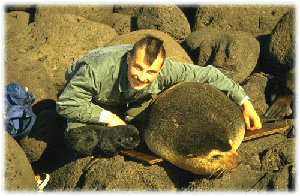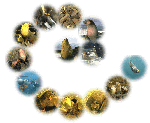| The first sailors - such as Valentyn in 1726 - used to note the tremendous number of fur seals along the coasts of Amsterdam up to the end of the 18th century. The whole shoreline seemed then to be so entirely covered with fur seals that any attempt of landing appeared difficult. In 1791 Cox landed on the island and went bludgeoning through the colonies. From the 18th century onwards, sealskin hunters took interest in the abundance of fur seals on Amsterdam and Saint Paul Islands. |
|
" The first seal-hunting expeditions (Mercury and Noolka) reached these two islands at the end of the 18th century and were of great benefit. The crew of the Mercury for example slaughtered 1,200 fur seals in 9 days on Saint Paul Island at the beginning of June 1789, which was far from being the best season for such an expedition. Three years later the crews of two sealing ships (Alliance and Asia) met in March 1792 a fur-hunter who had gathered 15,000 furs. Soon after an increasing number of expeditions took place because of the opening of the Chinese market which allowed a quicker selling of the furs during the return voyages. At least eight sealers went round the two islands between 1792 and 1796 and 22 sealers were registered between 1789 and 1832 - some of them coming several times or leaving hunting teams ashore for a few week to several year long stays. Along with those sealing expeditions a great number of whalers foamed the inshore waters of these two islands which were then very rich in large cetaceans. Those whalers also took an active part in the pinniped fur trade".
It was only in 1956 that Paulian mentioned three isolated sites on the northern and western coasts of Amsterdam with an estimated total population of about 2,300 individuals. Since 1982 the seal population on the isles of Saint Paul and Amsterdam has apparently kept steady to about 50,000 individuals with 11,000 new arrivals each year. A research program is in course since 1994 by the Centre d'Etudes Biologiques de Chizé. |
 The
history of the skin-hunting operations was recorded by Roux (1986)
who did not make of it an exhaustive review.
The
history of the skin-hunting operations was recorded by Roux (1986)
who did not make of it an exhaustive review. Unknown to us with accuracy are the exact figures dealing
with fur seals that either lived on Amsterdam Island before those
expeditions or were slaughtered at that time, or that managed
to survive. More than 150,000 furs were thus "levied"
between 1799 and 1835 on Saint Paul and Amsterdam Islands.
Unknown to us with accuracy are the exact figures dealing
with fur seals that either lived on Amsterdam Island before those
expeditions or were slaughtered at that time, or that managed
to survive. More than 150,000 furs were thus "levied"
between 1799 and 1835 on Saint Paul and Amsterdam Islands.  From 1835, after less than 40 years of hunting, there were
no fur seals left on Saint Paul Island, the most hunted of both
isles. Towards 1876-1880 those expeditions were put to an end
at Amsterdam because the species was no longer worth the trade.
The fur seal was then considered as extinct at Amsterdam.
From 1835, after less than 40 years of hunting, there were
no fur seals left on Saint Paul Island, the most hunted of both
isles. Towards 1876-1880 those expeditions were put to an end
at Amsterdam because the species was no longer worth the trade.
The fur seal was then considered as extinct at Amsterdam.